When it comes to annual performance reviews, I find it more effective to break them up into two meetings. In the first meeting, the Performance Review, I align it with the bonus plan, and it is strictly about setting objectives and achieving them. The second meeting, which I call the Annual Review, is a coaching and counseling session between the manager and employee.
One reason I break the review into two parts is that if you have a good or bad year performance-wise, anything other than average, then you don’t hear the coaching advice that comes up during the annual review. Or, the employee is nervous and doesn’t hear the information or is more concerned with the financial aspect, so they don’t pay attention. If you do it up front, then the employee is thinking about it afterward and trying to reclama, a military term used to formally ask for reconsideration, the feedback or salary adjustment.
Annual Review
To create an environment conducive to the employee receiving the most from the feedback, I prefer to use the Annual Review to talk about general overall performance and corporate values. I want to coach all my employees – for the current year, next year, and five years out – and find that this is the perfect opportunity.
My ideal review, which is approximately one and a half to two hours long, contains the following:
- 360 Degree Perception of Performance
This frank communication to the employee includes perceptions from around the company – colleagues, managers, and subordinates – regarding his/her performance.
- 360 Degree Perception of Adherence to Corporate Values
I discuss the perceptions of those surrounding the employee about their adherence to corporate values.
- Appropriateness of Current Role
We talk about the employee’s fit for this particular job.
- Other Possible Contributions
This section focuses on possible other areas where the employee might have talent and a capacity to contribute.
- 5-Year Growth Plan
This discussion centers around both the employee’s and manager’s goals for career evolution over the next five years, including stretch goals.
- Long-Term Career Aspirations
What possible career directions are possible given the employee’s capabilities?
- Training or Education Needs
Based on the growth plan and long-term aspirations, the employee and manager review internal and external training opportunities, whether corporate- or employee-sponsored. Additionally, they discuss any educational programs, such as degrees or certifications, that may be appropriate and possible chances of co-sponsorship.
- Manager and Employee Relationship
I recommend setting time aside so that the employee can provide feedback to the manager about their working relationship, addressing any concerns they have. - High-Priority Action Items
This summarizes any high-priority items identified in order to provide extra emphasis. Typically, I include one to five action items for the person to work on to move his/her career ahead, make a better fit for the role, or improve performance.
Note that in items 1 and 2 I talk about perceptions of performance and company values from the people around the employee. This is important because it provides the impression that people have.
Perception = Reality + Communication
Maybe an employee, in reality, is doing their job, but the communication of it is not clear. In my experience, the perception isn’t always correct, but where there’s smoke, there’s usually fire. If there’s a certain reality, it doesn’t mean it’s achieved. If the perception doesn’t match reality, then we need to dissect it and find a combination of reality and communication that create the desired perception.
I find that the use of the Perception Equation really helps new managers bring up difficult topics during the Annual Review. It allows the manager to say “here is the perception of your performance.” To impact the perception, we need a plan to impact the reality of your performance and then how ‘we’ communicate it to others. This, in a sense, puts the manager into a coaching/collaborative role rather than a judgmental one.
For these meetings, I fill out a form with feedback on each of these areas, but I also like to have an additional tool in my toolbox to help me with the conversations, especially when the discussion contains challenging aspects. During the Annual Review, I use a combination of the perception equation and a matrix to map an employee based on their performance and adherence to corporate values.
The Evolution of the BCG Matrix
In 1968, Bruce Henderson, the founder of the Boston Consulting Group (BCG), created the BCG Matrix to help companies identify where to invest their resources, such as which markets and business units, based on market growth and market share. The BCG Matrix, also called the Growth-Share Matrix, grew in popularity and almost every management program includes a discussion on it.
The original BCG Matrix looked like this:
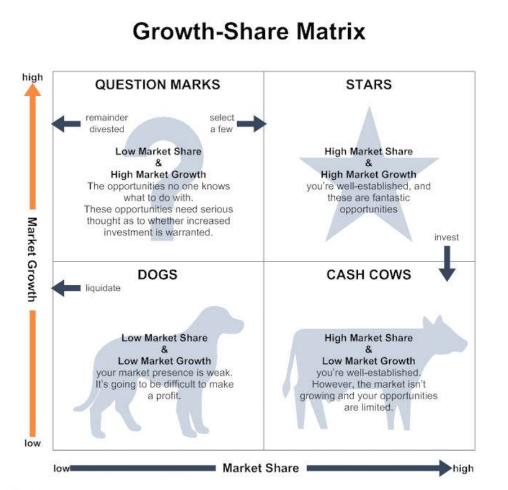
Companies put their current businesses into the matrix based on whether they have a high or low market share and the growth potential of their market. The location in each square can be anywhere, not just in the square itself. For example, a business may be in the Stars category but barely inside the square abutting Question Marks. The goal is to separate the businesses into quadrants.
- Stars: High market share and high market growth
- Cash Cows: High market share but low market growth
- Dogs: Low market share and low market growth
- Question Marks: Low market share but high market growth
Obviously, you want your business to be a star, meaning you already have a high market share in a market that’s taking off. It’s a fantastic place to be. A cash cow – meaning you are well-established with a strong market presence but the industry isn’t growing – is a strong position, so milk it for all it’s worth. But realize that its livelihood will ultimately expire because growth is going to slow and become anemic. Even if you have a strong position today, you probably cannot rely on it in the long term. Being a dog is the worst. You currently have a low market share, and the market has little potential for growth.
The big unknown is the upper-left quadrant. The business currently has low market share, but the growth potential is high. This could be a fantastic market, but you aren’t in a position to take advantage of it now. You have two options. 1) Get out of this business, or 2) Select areas where you can make an investment and see if you can grow your position in the market.
BCG gave advice on how to separate your businesses into these quadrants and helped you decided what to do and invest in. After completing the exercise, you knew how to proceed with each unit.
- Stars: Continue to invest and grow the business.
- Cash Cows: Don’t invest anymore, milk them for what they are worth.
- Dogs: Liquidate.
- Question Marks: Either get out, try to turn the business into a star, or liquidate.
SBC Matrix Applied to Employees
Because it was extremely popular, human resource (HR) departments adjusted it to their needs and started applying the process to employees with axes of job performance and potential. And, this was the result:
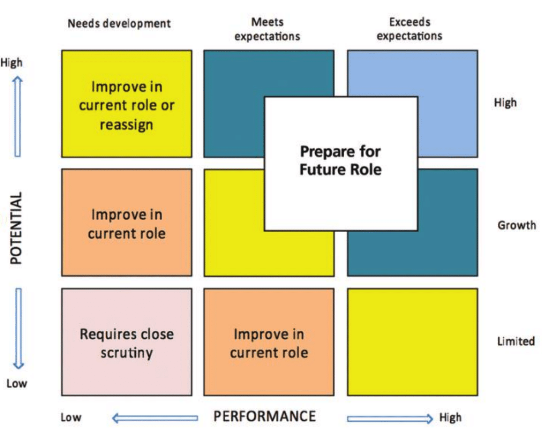
Instead of a 2×2 matrix, they increased it to a 3×3. It was a much more complicated rendition that didn’t last long. But what they tried to do was to categorize people into roles where they would be successful and thrive. The next version looked something like this:
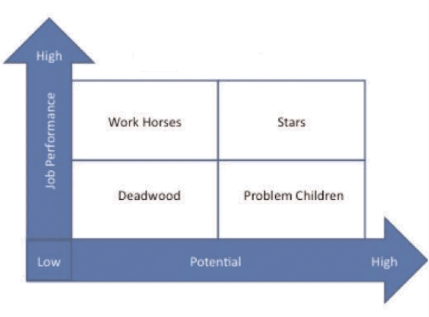
The goal was to invest in the Stars, get rid of the Deadwood, retrain the Problem Children, and use the Work Horses to drive the business. This was the beginning for organizations to start using the matrix in earnest. Jack Welch, CEO of General Electric for nearly 20 years, modified the model to fit his needs of assessing managers. He introduced corporate values into the equation instead of employee potential. Welch’s matrix looked like this:
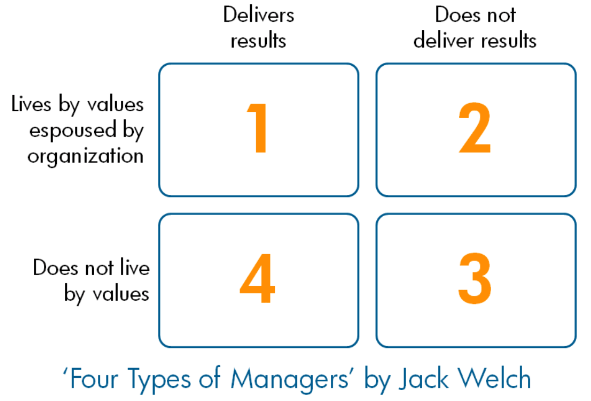
Welch, as well as GE, wrote and published numerous papers on this matrix. They conducted various talks, and it was prevalent in the 80s and into the 90s. And, it continued to evolve into:
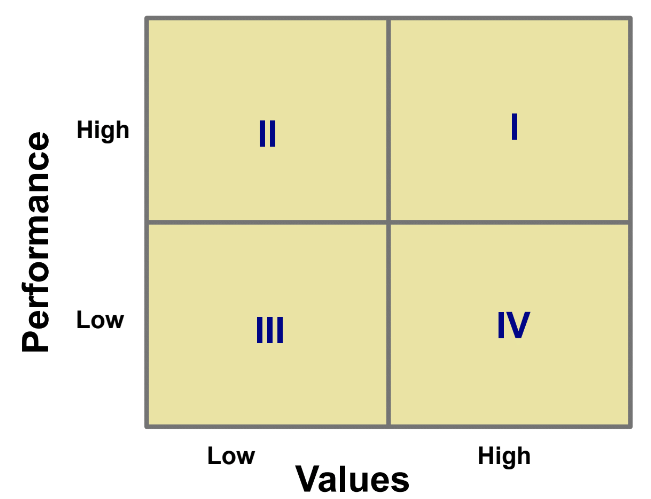
Many articles were written about Welsh’s work. One in particular stands out. Harvard Business Review Online published an article by Eric C. Sinoway on October 15, 2012 entitled, “When to Fire a Top Performer Who Hurts Your Company’s Culture.” He felt strongly that employees who undermined corporate values should be terminated, even if they were high performers. He called them “Vampires.” Sinoway and Harvard Business School Professor Howard Stevenson came up with the following employee classification system:
- Stars: These are the people who perform well and in a way that supports the organizational culture.
- High Potentials: While they support the values of the company, they underperform. They, however, have the potential to become Stars with training and mentoring.
- Zombies: These employees neither support the culture nor perform up to corporate standards.
- Vampires: These people are a real threat to an organization. They perform well in their job but are at odds with the company’s culture. Since they are high performers, they command a following from others in the organization, which increases the number of Vampires as well as Zombies, all of whom are misaligned with the corporate values. Soon, it’s them against the Stars and High Potentials.
The Sliwa Matrix
After reading and researching the various models, I created my own version, which I’ve tweaked over the years.
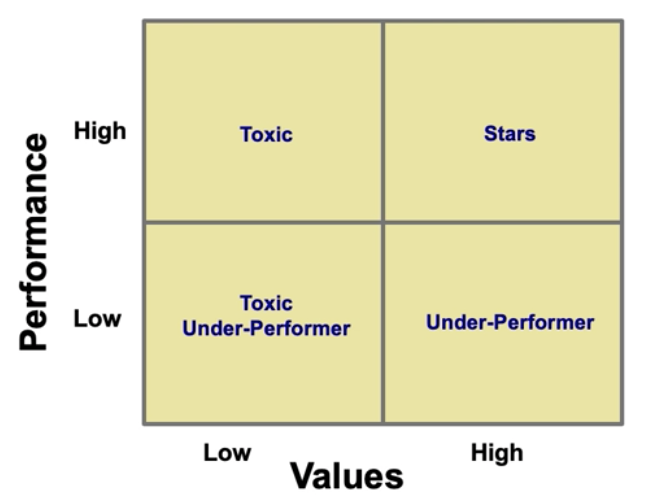
I consider an employee toxic if they don’t adhere to corporate values. They are toxic to the work environment and those around them. For example, a salesperson may be in the Toxic square if they continually meet their quota but overpromise. The customer ends up unhappy, complaining, and on the verge of dropping your company. The salesperson basically lied and overpromised, and the company is seen as underdelivering, which ends up creating a real problem.
Another example is someone who routinely finishes their work, but they are a grumpy butt. Yes, this is a technical term I frequently use because it accurately describes their behavior, which can be infectious. They are never happy. They spend their extra time, after all they are very efficient, by polluting the environment for others by talking down about customers, their boss or team, and the organization. They ruin the morale and environment. They may accomplish their work, but they bring down those around them.
Putting the Sliwa Matrix into Action
What I did in companies that needed a significant turnaround was to have managers put all the employees in their department somewhere on the curve in one of the quadrants. Some might be slightly in the Stars square or solidly in the Toxic square. To do this, the managers had to collect data from the people around the employee in order to create an accurate perception of the employee’s performance and adherence to values. This exercise was not subjective but based on evidence. In some cases, I had managers attach arrows to the employees’ names showing the direction they were headed.
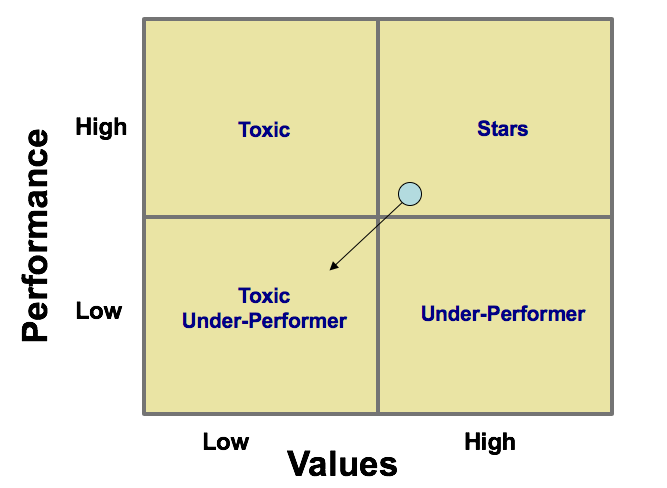
With this information, the manager can conduct an Annual Review to have a productive conversation about an employee’s performance, value, and perception. The manager would say that the employee is in the Stars category now but is moving in a downward path. You tell them that they are obviously not happy, being a grumpy butt, and their performance is going in the opposite direction than what they want. This gives a concrete way to talk about the perception, which may or may not be reality, and provides an opportunity to alter the communication. The manager says, “This may not be true, but it is the perception.”
In the review, the manager and employee develop a plan to change the direction and move solidly into the Stars quadrant. What can the employee do to change the reality and communication to come across as a star? And, what can the manager do to help the employee have that reality and communicate that to others so that they appreciate that the employee is seen as providing value?
What can you do as a manager to encourage your employee? Have a conversation that goes something like this… “Some people see you as bad-tempered, what can you do to improve the reality, i.e., improve your attitude, and then communicate it?” Or, you can also say that if the employee accomplishes this milestone and achieves this metric, then you, as the manager, can publicly recognize that achievement. Once the employee changes their behavior, then people will see them as team players and someone they want to be around. This benefits everyone and adds energy to the team. In my experience, it’s more than worth the effort.
Manager’s Matrix
As a leader, you have to decide what to do with an employee based on their placement along the curve.
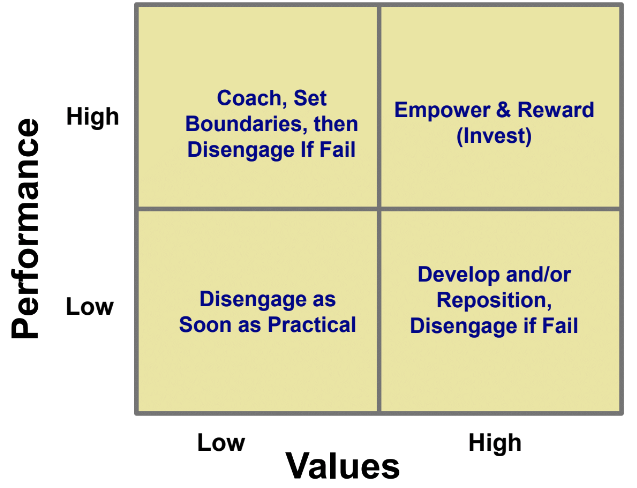
I use this matrix to remind leaders how to guide their decisions on personnel matters.
- Low Values, Low Performance: Disengage as soon as possible. Let them move on and set them up for success somewhere else. Tell them that they deserve a star, so put them on their way to find that position.
- High Values, Low Performance: These people are tricky because they align with the corporate values, and we like them and think they are going to be good for business. But they just haven’t achieved the necessary performance goals. Invest more in them because of the value aspect, especially in coaching them to increase their performance. Provide them with a task they can achieve and put them on a successful path. If that doesn’t work, try to find a new role for them where they can have high performance because they already share the corporate values. You have a 50-60% chance of making this work out. If you cannot coach them or provide a new role, then you must disengage in order to curtail bureaucratic growth. As above, tell them to find their star position.
- Low Values, High Performance: While these employees seem to be providing revenue, they may be sabotaging your business, ruining the performance of others by dragging them down, and tanking your reputation. You can coach these employees, but it’s tough for people to change their values. They tend to overpromise no matter how much you coach them. If they are a negative person or simply not happy with the company, there isn’t much you can do. It’s hard to put a band aid on this and make it work. I would say that 10-15% of the time, with proper coaching, you can turn the situation around to where they share the corporate values and become Stars. Try to coach them, but keep them on a short leash. Let them go if necessary.
- High Values, High Performance: These are your most valuable employees. Empower and reward them. Don’t forget to invest in them by providing them with the resources they need to be successful. More than likely, the company will receive a good return on that investment.
This matrix helps me when I have to separate someone. I tell the employee that they need to be in a position where they are high-performance, happy with their job, and completely aligned with the corporate values.
Overall Goal
Basically, your goal is to make everyone a star. If you cannot make them into a star in your organization, then they need to be set loose and head off to another company. I continue to be amazed at the number of people that I set off in other directions who became stars. When a position didn’t work out, I coached them to try something new, and low and behold, they ended up with high-performing careers in another direction. That is specifically what you are trying to achieve. This is a win-win for the organization and employee. Either way, however, your first responsibility is to your organization. Using this approach will help you to have meaningful and perhaps tough conversations to improve performance or reshape the organization.
Share this Post

